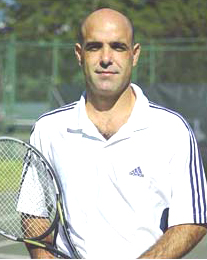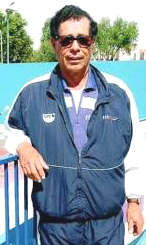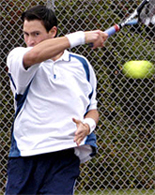
Two Coaches, Two Major Styles
| |||||||||||||||||||||||||||||||

|
Gilad Bloom: my former coach and architect of the attacking style. |
I have had serendipitous opportunities in my tennis career--as a player and as a coach--to train and study with some of the most legendary and smartest coaches in the game.
From all of my travels and study, two coaching heavyweights--I would call them geniuses--stand out from the rest. These elite coaches are Gilad Bloom and Pato Alvarez. Likely you have never have heard of either. But in these two articles I am going to explicate what makes them geniuses in my view—and what you can learn from both.
Gilad Bloom, a former ATP top 100 player, as well as an Israeli Davis Cup player and coach, was my personal coach for several years as I pursued a professional playing career. He was also my coaching mentor as I transitioned into high performance junior coaching.
Pato Alvarez, a former top 10 tour player, was National Coach for Spain and also coached many top junior and professional players such as Emilio Sanchez and Sergio Casal. Pato is the architect of the very successful Sanchez-Casal Academy training system. I was lucky enough to personally study with Pato on court at the academy in Barcelona, and I have also received certification in the Sanchez-Casal system that he designed.

|
Pato Alvarez: founder of the Spanish training system. |
Gilad and Pato may not be well known, but they have both had a profound influence on my teaching methodology and training philosophy as a high performance coach.
They also have radically different philosophies and styles. In fact their viewpoints probably represent the polar extremes in the professional coaching world.
Gilad Bloom advocates an aggressive, uncompromising hard court attacking style. Pato Alvarez teaches a more defensive Spanish clay court approach. Yet both have been extremely effective in developing players.
I think the differences are fascinating and in these two articles I will compare and contrast their styles. But my point goes further. I believe that the exploration of the contradictions inevitably leads to a new paradigm in training.
By incorporating elements of both, we can develop a more complete approach that maximizes any player's development, not only elite juniors, but serious players at all levels.
I believe this is critical for players who want to reach their potential, and especially for those who may wish to win championships on all surfaces. The fusion of the two styles can produce the ultimate all-court player, a player who can succeed on the slowest clay and the fastest hard court, and everything in between.
Holding ground on the baseline: the hard court attacking style. |
Israeli Attack
When I first started training with Gilad Bloom, his essential tactical message was very clear--and Gilad never minced words. "You will hold your ground on the baseline and attack the ball at every opportunity. You will sprint to the ball and take time away from your opponent. You will constantly apply pressure by taking the ball early and on the rise."
At Gilad's academy, players on every court were commanded to "hold the line." They were told they should never back up and should take the ball very, very early. I had never seen players pounce on a short ball so quickly or pressure the opponent by taking the ball so early on the baseline.
It was beautiful to see even young players learning to attack and not push the ball from ten feet behind the baseline, as many of our top juniors still do today.
This aggressive, on-the-rise philosophy is definitely a fast court coaching style. It is the kind of approach one might find in any region that has fast hard, grass, or indoor courts, such as England, Scandinavian countries, Australia, and India, to name a few.
This is also the way McEnroe and Connors played, when the tour was predominantly on grass, faster hard courts, and fast indoor carpet. Flatter ball striking, more linear stances and strokes, hugging the baseline and developing a quick transition and attack to the net. The focus is on the first two steps, which are sprinting steps to attack the ball relentlessly.
The Spanish Way: sliding rhythm steps to defend and "receive" the ball. |
Spanish Clay
The Spanish clay court philosophy could not be more different. In stark contrast to Gilad, Pato's students spend a tremendous amount of time learning to defend the ball—to back up from the baseline 6-8 feet or more and play defense.
This is often called "receiving the ball" in Spain and it is a very important skill that Spanish coaches work on constantly with their students. In Spain, players are discouraged from "fighting the ball," that is, trying to hold position on the baseline and taking the ball on the rise—exactly what Gilad teaches his students to do.
To properly receive the ball, Pato has his students move not by sprinting, but by using rhythm steps, sliding shuffle steps that create phenomenal balance.
Footwork
This is the biggest difference technically between Gilad and Pato--the footwork. Movement is at the root of their contradictory tactical approaches.
Both Spanish and Israeli approaches focus heavily on foot skills–and brilliantly so—it is just that they train the lower body to move in very different ways.
Rhythm steps: a fixed center of gravity and ultimate balance. |
Spanish students are discouraged from sprinting except in emergency situations. Rather, they are taught to command the center of the backcourt using rhythm steps. Although the concept is not widely understood in American tennis, rhythm steps are the foundation of the Spanish movement philosophy.
Pato told me that he never wants his students to sprint—they should only move with rhythm steps. Why? Because rhythm steps give a player the ability to move with a fixed center of gravity—ultimate balance. And balance is one of the main focus points for Spanish coaches.
To sprint, by definition, is to lose balance, by shifting the weight and center of gravity forward/back or left/right to initiate the first step. Rhythm steps, however, allow the player to move with perfect stability.
Thus for the Spanish, in the movement to the ball, a premium is placed on balance and stability rather than ultimate speed. Moving with rhythm is biomechanically slower than a sprint, but the player will never lose traction and slip on the clay and he will arrive at the ball in perfect balance and perfectly prepared to strike the ball.
The sprint: the pivot, two steps to the ball, crossover recovery. |
In Gilad's system, the sprint is the holy grail. How quickly can a player pivot and sprint in the first two steps to the ball? That's what the training focuses on. While rhythm can sometimes be seen in Gilad's training, the sprint, explosive recovery steps, crossover and carioca steps are the dominant skill taught.
Spanish Stroke Technique
From my observations, Spanish stroke technique is almost by definition the absence of strict technical training. Technical training in Spain is very open minded and laissez-faire, as it is in many clay court dominated regions such as South America.
Perhaps this is because of cultural differences or perhaps because clay courts tend to inherently promote improvisation and creative shot-making. Whatever the root cause, in Spain there is clearly a broad acceptance of various forms and styles of stroke mechanics. However, there are two postulates that undergird all of the technical approaches and styles. The first is balance. The second is racket head speed.
The Spanish emphasize drills that build maximum racket speed. |
Racket Speed
Racket speed to develop heavy spin and a heavy ball is the technical holy grail in Spain. It seems to be what all top Spanish coaches I have studied with are looking for and the main focus of their technical training and drills. Racket speed is king.
I have observed countless Spanish coaches, including Pato, implementing clever drills to generate more whip and racquet head acceleration, including drills fed by hand from close in to the player. And if you have ever played on slow European red clay, you will understand why racket speed is so critical to the clay court training philosophy.
The conditions are just so heavy and slow that without tremendous racket speed, the player cannot hit deep, aggressive shots, capitalize on short balls, or even play an effective defense from deep in the court.
Therefore in Spain—as in South America and other clay dominated regions--players often gravitate toward very open stances, sometimes wild roundhouse swing paths, and more extreme grips (Think Nadal, Guga, Sergi Bruguera, Alberto Berasategui, or Thomas Muster for good examples). This is all in the quest for racket speed.
The Spanish emphasis is on training the lower body, not the technical swing. |
Now, this technical style is great if the player wants to win Monte Carlo or Roland Garros. But those more extreme grips and heavy spin balls—until the emergence of Rafael Nadal—have not translated as well to Wimbledon or the US Open. But as Dave Hagler has recently pointed out (Click Here) the speed of the courts and balls have gradually slowed both at Wimbledon and in New York.
Balance
Balance permeates every technical adjustment for the typical Spanish coach. Pato is obsessed with balance, as exemplified by his rhythm footwork system and, as we shall see in the next article, in other technical areas such as stances. In Spain, on the slippery clay, players must learn to develop graceful movement or they simply cannot become champions.
The instability of the clay surface breeds coaches who naturally place a strong emphasize on building a stable foundation for every shot. Thus Spanish coaches tend to spend a lot of time training the lower body and movement as opposed to focusing primarily on the upper body techniques regarding the racket path itself.
Pato emphasizes moving to the ball with a balanced rhythm and creating a stable base before making contact with the ball. Carioca and any kind of crossover steps are discouraged. Every jump must be counterbalanced as well.
Gilad prefers more conservative grips and flatter hitting. |
Hard Court Technical Style
Gilad's technical training is very different from the Spanish approach. He prefers more conservative strong eastern to semi-western grips, cleaner and flatter ball hitting, and more aggressive on-the-rise linear stances and weight-transfers.
This makes sense coming from a hard court populated country like Israel that has few, if any, clay courts. It's analogous to the training in Southern California by great coaches such as Robert Lansdorp, who also emphasizes more conservative grips and stances, taking the ball early and hitting a flatter ball.
On a fast court, players are rewarded for their aggressiveness and for an all-out attacking style of game. On slow European clay, this approach can seem somewhat foolish, as many Americans have discovered at Roland Garros.
Gilad of course wants racquet speed, but is not obsessed with it like the Spanish. In his system, power comes less from rotation (angular momentum) and more from forward transfer.
For Gilad, the key to balance is head position. |
Balance is also important to a coach like Gilad. Like Pato, Gilad is obsessed with posture and center of gravity. I have never seen a coach more obsessed with keeping the head still than Gilad Bloom.
The head is critical in maintaining posture and balance, and every student at his academy when I worked there was brainwashed to keep the head still through the ball contact, much like Federer does on all his shots.
But more interestingly, my experience with Israeli coaches is that they are very particular about how the technical form should be, very much like classical martial arts or ballet teachers. Gilad was absolutely punctilious about proper form—obsessed with every technical detail. Some of this may be cultural, but I believe the laissez-faire approach and the strict, structured approach symbolize a much larger divide in the coaching community about how to teach tennis technique.
On one hand—and I am generalizing to a certain extent--you have the Spanish and South Americans for example, who are very laid back about form. I call this the "intuitive" technical coaching model.
Intuitive coaches like to let their students "feel" their own strokes and learn through experience rather than by dogmatically shoving a strict form down their throats. In my opinion, more intuitive coaches come from clay dominated regions than anywhere else. Luis Bruguera, whom I have also studied with in Barcelona, is a classic example.
Sergi Bruguera:intuitive coach and a unique technical style. |
Players who train under intuitive style coaches often develop unusual, unorthodox technical swing patterns. Bruguera coached his son Sergi and well as Alberto Beresetegui who both had relatively unorthodox grips and technique. And I believe Pato is very open-minded technically in terms of strokes.
On the other hand, some coaches enforce a much stricter technical training paradigm. Gilad's coaching is more dogmatic, very regimented, and structured. The coach is the expert—the boss--and he instructs the student on exactly how he or she will strike the ball. This is similar to the Russian way and also the classical approach found in many Eastern European and Asian technical teaching models.
I find this dichotomy in tennis pedagogy truly fascinating. It is a teaching debate that continues in many different arenas today. For example, there is a debate in modern education about whether intuitive games-based learning is more effective than rote drilling in mathematics instruction, or whether some combination of the two approaches is more effective.
The games based teaching approach in tennis, including the recent Quickstart playing format, has become a more common phenomenon here in the U.S. and it is based on an intuitive philosophy of learning. The ubiquity of the intuitive style, I would argue has hurt the technical development of players in this country, but that is my own opinion.
Technical innovations like the reverse finish tends to emerge with intuitive coaching. |
The intuitive approach, however, does have one very powerful advantage: it allows for technical innovation to flourish. My Israeli coach would have never allowed the reverse finish of a Nadal, for example.
But I believe that without some room for experimentation by young, talented players, technical innovation would come to a grinding halt. I believe this is why players who grow up on clay courts tend to set technical trends, because improvisation is par for the course.
The low, across the body forehand finish, sometimes called the winshield wiper, is an example of a trendsetting technical innovation, started by creative clay court players in Europe and South America, and it has proven to reliably provide more power, spin and racquet speed.
Still, the advantages of a strict technical model, like the Israeli approach, are numerous. Players that learn under a structured system tend to spend less time in trial-and-error, and thus pickup world-class technique faster. Less talented players, who are not as naturally gifted also tend to thrive under a model that offers clear guidance and structure.
The low, across the body finish, started by creative clay courters. |
If it seems that I am arguing both sides of the fence, this is true. As players develop they may gravitate more to one technical style, one style of movement, one style of coaching. And recognizing and facilitating this is part of the coaching art as well.
But my belief is that junior players—and in fact players at all levels—can only benefit from being exposed to concepts and training from both schools. This breadth of training I believe will increase the potential of a player and allow him to adapt to a variety of circumstances against other players and on different surfaces.
In the second article, I'll have more to say on this topic, and will introduce in more detail the training methods I have incorporated and developed based on both approaches. Stay tuned!
And, once again, special thanks to my student Hannah Shteyn for helping with the demonstrations!
This article is dedicated in memoriam to Valentina Shteyn.
She will be missed.
 |
Chris Lewit is the director of the Chris Lewit Tennis Academy, with locations in the New York City area. He has coached numerous nationally and internationally ranked junior players, including several current top American players. After playing #1 singles for Cornell University, Chris competed on the ITF and USTA pro satellite and futures tours. He is a member of both the USPTA and PTR, and a graduate of the USTA High Performance Coaching program. In addition, Chris has traveled internationally to study the game with some of the world's top coaches. This article was adapted from his forthcoming book, The Tennis Technique Bible, one of several current publication projects. Click Here to learn more about Chris's teaching system, his book projects, and his teaching academy. |
|
Contact Tennisplayer directly: jyandell@tennisplayer.net
Copyright Tennisplayer 2005. All Rights Reserved.

